Tanks with the prefix "super"
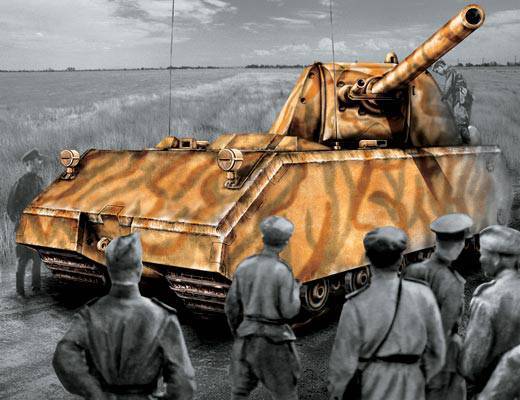
For nearly four decades, military theorists and designers have dreamed of powerful superheavy tanks... Land "unsinkable battleships" were never destined to appear on the battlefield, but in the process of their development, a lot of sound ideas were born, which were later embodied in "normal" tanks. Large-scale works of human hands have always attracted attention, aroused admiration, aroused fear and gave birth to legends. In the field of military technology, products with the prefix "over" are usually perceived as a tribute to gigantomania. “Everything that is over and above is too much,” says the wise proverb.
Vintage projects
The first known project of the machine, which has the right to be called a prototype tank, has already suffered gigantism. In 1874, the Frenchman Eduard Buyen suggested that a train carrying a railway track in the form of an enclosed chain encompassing it (for example, like a caterpillar covering a tanker rink), for movement in any terrain. The transverse bending of the chain allowed this machine to turn. For military purposes, Buyen designed a version of the “armored train” of eight sections, armed with 12 cannons and 4 mitraliases. The team was supposed to include the 200 man. It is clear that the proposed steam engine with a capacity of 40 l. with. I could not move this “the most formidable weapon of war”. The project settled in the archives, where he was discovered after half a century.
It ended in nothing and much more interesting development of the Russian shipbuilding engineer V.D. Mendeleev, son of D.I. Mendeleev. Mendeleev worked on the draft design of a ground machine from 1911, in his spare time from the main service. In August, 1916, when a month remained before the British tanks entered the battlefield, he submitted to the Russian Military Ministry a carefully developed project. And it was the first Russian project of the "tank". The popular version, according to which the all-terrain vehicle, built in the 1915 year by A.A. Porokhovschikov, erroneous. This car had no armor or weapons and was just an all-terrain vehicle. Mendeleev’s project assumed an armored vehicle with weapons.
And very solid - 120-mm cannon "Kane" in the body and the machine gun "Maxim" in the retractable turret. The reservation was supposed to protect against 152-mm projectiles. Pneumatic chassis suspension assemblies and control servo drives were envisaged. It is curious that during the shooting the body of the car had to fall to the ground. Was provided for transportation by rail. Mendeleev did not specify the scope of his "armored car." Perhaps it was intended for the land war or coastal and antiamphibious defense of the Gulf of Finland. However, the machine mass 170 t, very difficult to manufacture, no one interested.

The first "in the gland"
15 September 1916 on the Somme for the first time went into battle with British tanks. In November, the development of its own tanks was authorized by the German military leadership. We started with the heavy tank A7V weighing 30 tons, but in the spring of 1917, the head of the design work, J. Vollmer, was assigned to develop the 150 tons and 28 vehicles on June 1917, the war ministry approved the KW project (Colossal-Wagen) . The layout of the Colossal was generally borrowed from the British: the caterpillars covered the hull, and the weapons — four caponier guns and 6 — 7 machine guns — were mounted in sponsons and in airborne embrasures. Originally executed chassis: rollers mounted on tracks caterpillars, so that the caterpillar itself rolled along the rails around the body. The armored screens covering the upper branches of the tracks greatly reduced the ability to overcome high obstacles. In fact, the Colossal was an artillery battery and a machine-gun company, hidden in one "mobile fort." From here and record for crews really constructed tanks - 22 of the person. For transportation by rail, Kolosal understood 15 — 20 parts. By the end of the war, only one of the 10 tanks ordered was assembled at the Ribe plant, the hull and main units were ready for the second, and all of this was scrapped after the defeat of Germany.
The British also thought about giant tanks. True, their project 100-ton "Flying Elephant", developed in 1916 year, remained unfulfilled. The wagon-shaped hull of the “tank elephant”, supported by two caterpillars, was also equipped with a pair of caterpillars under the bottom to prevent the machine from “hanging” on obstacles.
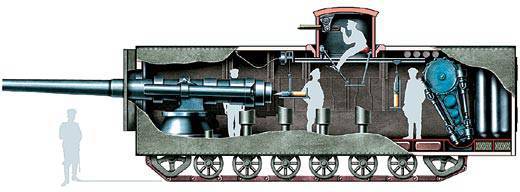
“Land battleships” and “barrier breakers”
A message about the appearance of tanks on the battlefield in September 1916, the Times correspondent, ended with a forecast: “It is possible that we will see battles of whole fleets of land dreadnoughts and monitors.” This forecast was not born out of nothing - back in 1915, in the UK, the land cruiser project of Commander Hetterington was considered. The machine on three wheels with a diameter of 12 m each had to carry six 102-mm guns and 12 machine guns and weigh 1 000 tons. The project was rejected at the sketch stage.
In January, an anonymous inventor of 1916 offered armored “samo-guns” to the Russian military department, able to walk “on any kind of soil, independently crossing rivers and lakes”. On the “move” invented by him, the essence of which he kept secret, the inventor proposed to put the old Black Sea armadillos. Developing his thought further, the anonymus thought to launch a squadron of “self-propelled battleships”, “self-propelled cruisers”, “self-propelled guns”, some kind of “self-propelled hangar” and even remotely into a raid on the industrial areas of Northern Germany controlled "self-propelled-min."
This offer can, of course, smile. And one can remember that three years later J. Fuller would write about the future of the “prophet of mechanized war” tanks: “The fleets of these machines will maneuver between fortified forts, destroying each other with sea receptions.” Fuller will then move away from such radical theories, but the idea itself will be quite attractive. One of the main reasons for this is the development of fortification. After the First World War, the contours of extensive fortified areas, connected in a long, deeply developed defensive lines began to emerge. Since ancient times, assault vehicles were used to capture fortresses — the larger, the more solid the fortress was. Apparently, by analogy, the military found it necessary to have "assault towers" in the form of powerful, universally armed tanks in order to break into a powerful defense and break into its depth.
The tone was initially set by the French. The creator of the French tank forces, General Etienne, in 1921, painted a picture of the offensive, which is led by "breakthrough tanks weighing 50 or even 100 tons." These numbers are not frightened. Tanks experienced the time of adolescence, and went searching for types, designs and sizes. The 600-ton tank with the 155- and 75-mm guns, proposed in the open press by Colonel Welpri in the 1923 year, caused a heated discussion. Welpri made an analogy with the battle of the battleships. To which the opponents responded that it would be more accurate to compare the combat of a tank with field artillery with the confrontation between the battleship and the coastal battery. The advantages of the latter are obvious.
The winning positional school in France was interested in breakthrough tanks not because of “maritime analogies” and not from the standpoint of a deep offensive. The main task from the point of view of this school was to “crack” the front edge of the defense. The large size and weight of the tank promised to overcome the moats and escarpes, the destruction of obstacles and fortified structures, and the fire power - the suppression of fire defenders.
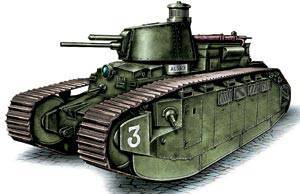 FCM had received an order for 300 2С heavy tanks before the end of the First World War, but at the end of the war the order was reduced to ten. The tracks of the 2C covered the hull, the 75-mm gun and one machine gun were installed in two towers, which is why the tank was very high. The armor was supposed to protect 77-mm German field guns from shells. The tanks were equipped with carburettor engines, repaired from Germany, and electric transmissions. The speed of the 12 km / h, a removable tail to overcome the wide moats answered the "positional" purpose of the tank.
FCM had received an order for 300 2С heavy tanks before the end of the First World War, but at the end of the war the order was reduced to ten. The tracks of the 2C covered the hull, the 75-mm gun and one machine gun were installed in two towers, which is why the tank was very high. The armor was supposed to protect 77-mm German field guns from shells. The tanks were equipped with carburettor engines, repaired from Germany, and electric transmissions. The speed of the 12 km / h, a removable tail to overcome the wide moats answered the "positional" purpose of the tank.In 1928, one 2С was upgraded, replacing the 155-mm cannon with a cannon, strengthening the booking and installing new engines. The mass of 2C bis reached 74 T. This was the upper limit of the heavy tank class - 75 — 80 T. It was funny that about one of the largest terrestrial animals weighed — the fossil lizard brachiosaurus. 2C never entered the battle. In June, 1940, the 6 units of the remaining serviceable tanks were broken when transported by rail to the front.
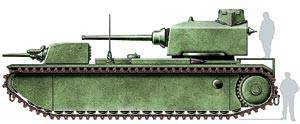 At the Geneva Conference on Disarmament 1932 — 1935, the French suggested that “offensive” weapons"Tanks are heavier than 92 T. Apparently, France was not going to stop there - after all, Germany had already begun to build the Siegfried Line on its western border. Anyway, in 1938, the French began the development of the F1 super heavy tank.
At the Geneva Conference on Disarmament 1932 — 1935, the French suggested that “offensive” weapons"Tanks are heavier than 92 T. Apparently, France was not going to stop there - after all, Germany had already begun to build the Siegfried Line on its western border. Anyway, in 1938, the French began the development of the F1 super heavy tank. The ARL design bureau and FCM offered several options. In the spring of 1940, FCM presented a full-size model of a 140-145 tank with long-barreled 90- and 47-mm cannons in two turrets, four machine guns, speeds up to 24 km / h - twice as much as the 2C. The war interrupted these works.
Germany, in turn, thought about the breakthrough of the French "Maginot Line". General Guderian, back in 1937, said that it was useful to have a small number of tanks in 75 — 100 t with 150-mm cannons for breaking through long-term fortifications. But the Germans did not do them, focusing on maneuverable medium tanks.
Even the Japanese, who prefer cars easier, not done without the "supertankov." In 1939, a three-towered 100-ton tank was developed in Japan with one 105-mm and two 37-mm cannons. Later, the project appeared tank type 100 "O-and" mass 120 t with 100-and 47-mm guns. It remains to assume that the task of such tanks was the assault of fortified areas on the Far Eastern borders of the USSR. True, the work on the Japanese super heavy tanks did not go - and could not go - beyond wooden layouts.
Reserve Command
In the 1929, the Department of Mechanization and Motorization (UMM) of the Red Army, among other tasks, also issued a task for the development of a “big tank” with 60 — 80 tons mass. In 75, the Military Academy of Mechanization and Motorization (VAMM) considered the design of a 80-ton breakthrough tank with a diesel engine, planetary transmission and hydropneumatic suspension. This set of innovations was very promising, but unaffordable for the then industry.
In those years, a German engineer E. Grote worked in the tank design bureau of the Leningrad plant “Bolshevik”. In March, 1932 of his group presented a draft of a TG-VI tank mass 70 — 75 t. On its basis, developed a draft 100-tonne T-42 with 107-, 76- and 45-mm cannons in three turrets, several machine guns, an engine in 2 000 l. with., electric transmission, individual suspension support rollers and servo control. The head of the same design office K.K. Sirken proposed his project for the 85-ton tank.
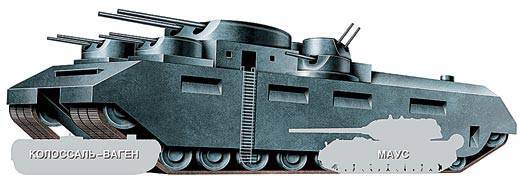
At the Leningrad Experimental Plant of Spetsmashtrest under the leadership of N.V. Barykova and P.N. Syachintova developed several variants of the 90 tonne-mounted T-39 tank with a crew of 12 people. His weapons included four 107-mm (or one 152- and two 107-mm), two 45-mm cannons, 2 — 4 machine guns and a flamethrower. Engine in 1 200 l. with. had to provide 24 — 33 km / h speed — the theory of deep operation required good mobility even from super-heavy tanks. The original feature of the undercarriage was the presence of an additional front pair of tracks, which made it easier to overcome obstacles. In June, the Scientific and Technical Committee of UMM examined these projects together with TG-VI, T-1933 and the 42 project of the Italian Ansaldo tank. Based on the discussion, Barykov and Ginzburg finalized the T-70 project. But the development of the tank and stopped at the stage of wooden layouts scale 39: 1. Already put on the production of 10-tonne five-tower tank T-50 (developed, by the way, under the leadership of the same Barykova), and the development of too "big" T-35 stopped.
Exploratory work on super heavy machines went on a broad front and did not limit the masses to 80 or 100. Back in March, the same Grote 1931 offered two variants of the 1 000-tonne super-machine with three and six towers. It was assumed that several engines total power 24 000 l. with. and hydromechanical transmissions provide travel speeds up to 60 km / h. On each side there were three tracks with a hydraulic suspension. The project was recognized extremely cumbersome and complex.
However, UMM became interested in the tank in 500 — 600 t. And in June, 1933, in the WAMM Research Department under the guidance of M.V. Danchenko developed a 500-ton tank project, armed with two 107-mm, two 76-mm and two 45-mm cannons, 4 — 12 machine guns, three flamethrowers and a mortar, with a crew of 60 people. Propulsion system in 6 000 l. with. was supposed to provide speed 30 km / h. This model, as you can see, is fully consistent with the concept of "land battleships."
A different approach was used in the development of the design of the “composite” 300-ton tank, proposed in 1934 by the Leningrad designer LS Troyanov. The tank was placed on two tracked chassis with steam engines for 1 500 l. with. and cross platform. A tower with a 203,2-mm howitzer was installed on the platform, and towers with 152-mm cannons were mounted on each chassis. When installed on the railway, the “tank” became an armored train. All these projects remained only on paper.
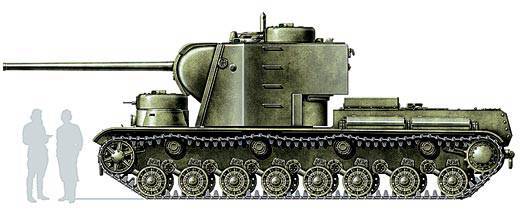
To breakthrough super heavy tanks returned on the eve of World War II. On the one hand, this was inspired by the experience of overcoming the “Mannerheim Line” during the Soviet-Finnish war. On the other hand, there was intelligence data (which turned out to be false) about the appearance in Germany of tanks with 60 — 80-mm armor and the corresponding armament. After the adoption of the Red Army in December 1939, the KV tank leading to heavy tanks was the SKB-2 of the Kirov factory under the guidance of J. Ya. Kotin. The Resolution of the Council of People's Commissars and the Central Committee of the CPSU (b) of 7 on April 1941 of the year provided for the development of superheavy KV-4 and KV-5. The order of the People's Commissar of Medium Machine Building from 9 of April clarified the task: on the KV-4 - the new 107-mm ZIS-6 gun developed by VG Grabina, armor up to 150 mm, according to KV-5 - gun ZIS-6, armor 150 — 170 mm. By 15 August 1941, they expected to receive samples of the hull and towers for the KV-4, and by October 1 - for the KV-5.
In search of solutions, Kotin announced in SKB-2 a contest for the draft design of the KV-4 (224 object) with 107-mm and 45-mm guns. At the beginning of June, more than 20 projects were presented, differing in layout and mass schemes - from 82,5 to 107 tons. On some tanks, a flamethrower was included in the armament.
Preliminary work allowed the development of the KV-5 (225 object). The conceptual design of the KV-4, prepared by N.V. Zeitz, who became the head of the further development of the 100-tonne KV-5. To accommodate the crew and 107-mm guns with armor-piercing and high-explosive fragmentation the tower was made high, so that the width of the tank fit on the railway platform. The height of the body was pressed down to 0,92 m, and the driver was placed in the wheelhouse, next to the gunner-radio operator, located in the machine-gun turret. In the absence of a new engine in 1 200 l. with. the power plant was assembled from two regular diesel engines for 600 l. with. Kotin’s last signature on the drawings was 22 August 1941, when the Nazis approached Leningrad. With the evacuation of the Kirov plant in Chelyabinsk work stopped. The war forced us to focus on improving mass-produced heavy tanks and increasing their output.
In the archives can be found and projects even more giant tanks. In the spring of 1940, the designers Popov and Nukhman proposed a series of three-tower VL tanks (“Vladimir Lenin”) weighing from 260 to 460 and carrying a crew of 15 people. The main weapon was to serve 130-mm or 305-mm naval gun, "auxiliary" - two 76-mm guns. The chassis with two tracks on each side (with independent drive on each) and the installation of three 800-strong diesel engines with electric transmission on traction engines from electric locomotives were assumed. But the giants were rejected at the stage of preliminary design.
It is worth noting that super heavy tanks in our country were just a design ground on a drawing board. The 68-tonne IS-7 became the heaviest among the built pilot tanks, and the 60-tonne IS-4 was among the production tanks. Both appeared after the war, in 1947.
Germanic "mouse"
Hardest to stories The tank was built in Germany. In June of the year 1942, when work on the heavy Pz.Kpfw VI “Tiger” was finished, the idea of a tank with an 128- or 150-mm gun and “maximum possible armor” surfaced at the meeting with Hitler. The development of the "205 device" was assigned to Professor F. Porsche, who used the location of the Fuhrer. Krupp, Daimler-Benz, Siemens-Shukkart, Skoda, Alkett were attracted to the works.
After the demonstration of 6 in May 1943, the wooden layout, Hitler confirmed the continuation of the work. Their only rationale was the same analogy with the sea battle - the one with the long-range cannon and thicker armor would win. The tank was called the "Mouse", which, by the way, means "mouse" and not "mouse", as can sometimes be found in literature. In January — March, 1944 tested the first 205 / 1 Mouse prototype with a carburetor engine; in the fall it was run-in with an assembled turret. So, the "Maus" can be considered the only super-heavy tank that has been tested and was one step away from adopting. The 205 / 2 prototype with a diesel engine was ready in October, but the power plant failed to test it.
A machine with 200 bookings — 240 mm and two 128 and 75 mm guns in a single unit made a strong impression. Talented designer Porsche used a number of interesting solutions in Mouse. Following the French, he turned to an electromechanical transmission, convenient in layout and control. Its bulkiness and high cost for a super-heavy tank did not matter much. It was allegedly not more difficult to control the giant than the Tiger, the crew consisted of only 5 — 6 people. There was an automatic fire extinguishing system, a duplicated communication system and a barrel bore blower. Water barriers were planned to be overcome along the bottom, since the use of bridges was impossible because of the enormous mass. Electricity and control signals to the sealed tank moving along the bottom were to be transmitted by cable from a car standing on the shore. The lack of “machine” machine guns demanded that it be covered by infantry and other tanks, so its most likely role was an “anti-tank fort” to strengthen the field defense. But, although they even managed to issue requirements for bringing the production to 10 machines per month, in December 1944, Hitler ordered to stop work. This, apparently, was achieved by the Minister of Weapons Speer and the Chief of the General Staff Guderian, who understood the unreality of the production and operation of such giants. The Third Reich was no longer up to such projects.
During the two world wars, the German military leadership issued assignments and allocated resources to the "super-tanks". Both times the designers laid in them original ideas and solutions, and both times the monsters were stillborn.
When Soviet troops approached the Kummersdorf test site in April 1945, both cars blew up. The reports that the Mauses were burned at the General Staff in Zossen and at the Reich Chancellery in Berlin are just a legend. The remnants of the “Mausov” and spare units in 1946 were delivered to the test site of the SRIH BT in Kubinka near Moscow, where Soviet specialists assembled one tank, examined it, and even fired at it. The research report noted a number of interesting decisions, high quality design and node fabrication. Now the team "Maus" with the case of 205 / 1 and the tower of 205 / 2 - an exhibit of the Military History Museum of armored weapons and equipment in Kubinka.
In June, 1943, the Wehrmacht Army Armaments Directorate, issued to Adler, the task of developing the E-100 tank. The index "E" (Entwicklung) meant belonging to a promising system of armored weapons, and not implemented. The E-100 was supposed to weigh the 140 t, armed with an 150- or 170-mm gun. But when the giants lost their priority, only three people left the Henschel plant in Paderborn to assemble the E100. Collected chassis took the British.
The name of the engineer Grote reappeared, who did not refuse from the supertanks after returning to Germany. In the same June, 1942, when work began on the Mouse, he, along with Dr. Gacker from the Ministry of Armaments, began developing the R.1000 tank “Ratte” (“rat”). The colossus in 1 000 tons of weight, 35 length, 14 width and 11 height m had to carry two 280-mm naval guns and one 128-mm, and to deal with airplanes six or eight 20-mm anti-aircraft guns. "Ratte" was set in motion by several ship engines.
By December, Krupp produced a preliminary design of the P.1942 tank in the 1500 1 T. A sort of self-propelled gun carriage for the Dora 500-mm cannon, carrying two more 800-mm guns and four diesel engines as an "auxiliary" armament, used in submarines. Already at the beginning of 150, the Minister of Weapons Speer stopped work on both projects, of which nothing constructive would have come out.
Allied Turtles
The British began to create a breakthrough tank before the war, assuming that in the event of war "on the continent" they would storm fortifications like the German "Siegfried Line". In 1939, a committee was formed, which included respected veterans of the British tank industry - A. Stern, J. D'Encourt, E. Swinton, G. Riccardo, W. Wilson. The production was launched at the pioneer of tank construction company Foster. The designers called themselves “The Old Gang” - “the old shift”, and the project prepared by them received the designation TOG. In October, an experienced TOG 1940 tank was built on 1, and a TOG 1941 tank was built on 2 in May. Their design testified, rather, to trying to return to the old canons, than to striving to do something new. The suspension was stiff, it was even planned to install weapons in the airborne sponsons. The “old shift” nevertheless installed a turret with a long-barreled 76-mm gun and electric drive, and also used an electric transmission. Caterpillars, like the French 2C, covered the body. True, the 600-strong engine was rather weak for a machine weighing 81 tons. It was never launched into the TOG series. Now he decorates the exposition of the Royal Tank Museum in Bovington.
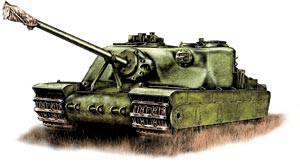 Based on the experience of fighting in North Africa, the British decided to develop an “assault tank” with armor protecting against most of the known anti-tank weapons and a strong anti-tank gun. The order for development at the end of 1942 was received by the firm “Nuffield”, where the works were headed by M. Thomas. From the project AT-1, after a series of refinements and changes, they reached AT-16. He became the basis of the "tank" A39 "Toroyz" ("Turtle"). With a long-barreled 95-mm separate loading gun and armor thickness up to 225 mm, the Turtle weighed in under the 80 T. The manual transmission allowed for a turn in place, only it was not easy to find a place for such a turn. The order for 25 units was reduced first to 12, and in February 1946 of the year to 6. Interest in the cars went out, and in April 1948-nd two of them were sent to the British occupation zone in Germany, rather, to test the possibility of transporting such heavy machines than for testing.
Based on the experience of fighting in North Africa, the British decided to develop an “assault tank” with armor protecting against most of the known anti-tank weapons and a strong anti-tank gun. The order for development at the end of 1942 was received by the firm “Nuffield”, where the works were headed by M. Thomas. From the project AT-1, after a series of refinements and changes, they reached AT-16. He became the basis of the "tank" A39 "Toroyz" ("Turtle"). With a long-barreled 95-mm separate loading gun and armor thickness up to 225 mm, the Turtle weighed in under the 80 T. The manual transmission allowed for a turn in place, only it was not easy to find a place for such a turn. The order for 25 units was reduced first to 12, and in February 1946 of the year to 6. Interest in the cars went out, and in April 1948-nd two of them were sent to the British occupation zone in Germany, rather, to test the possibility of transporting such heavy machines than for testing.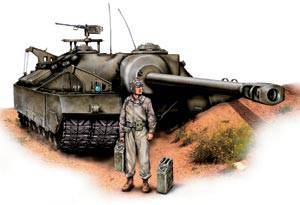 But during the war years they “ran” the path from the archaic idea of a four-turreted tank - through the 55-ton single-column М6 built with a small series - to an assault vehicle with a long-barreled gun. The artillery and technical service began work on the latest project in September 1943. The resulting 90-tonne T28 with a record-breaking 305 mm frontal armor thickness was essentially a self-propelled 105-mm gun. So they wanted to designate it, but still attributed to the tanks. The ammunition consisted of armor-piercing and concrete-piercing shells - the Americans were going to storm the German "West Wall" in France. Five cars ordered Pacific Car and Foundry in May on 1945, when Germany had already capitulated. After the end of the war with Japan, the order was reduced to two cars that were tested in the USA before the end of 1947. One surviving T28 became an exhibit at the Patton Museum in Fort Knox.
But during the war years they “ran” the path from the archaic idea of a four-turreted tank - through the 55-ton single-column М6 built with a small series - to an assault vehicle with a long-barreled gun. The artillery and technical service began work on the latest project in September 1943. The resulting 90-tonne T28 with a record-breaking 305 mm frontal armor thickness was essentially a self-propelled 105-mm gun. So they wanted to designate it, but still attributed to the tanks. The ammunition consisted of armor-piercing and concrete-piercing shells - the Americans were going to storm the German "West Wall" in France. Five cars ordered Pacific Car and Foundry in May on 1945, when Germany had already capitulated. After the end of the war with Japan, the order was reduced to two cars that were tested in the USA before the end of 1947. One surviving T28 became an exhibit at the Patton Museum in Fort Knox.Both the T28 and the "Turtles" created a lot of problems during transportation. To reduce the width of the "Turtle" removed side screens and external carts chassis. The T28 had two tracks on each side. External during transportation were removed, and on the march were towed behind the car, like a trolley. Speed A39 and T28 was really "turtle." But in their design they tried out a number of new solutions - welding thick cast parts of armor, installing anti-aircraft machine guns, new suspension schemes, control drives.
The next experienced American assault tank - the 90-tonne T30 - was already carrying an 155-mm cannon in the turret. But the days of super heavy machines were numbered.
The development of anti-tank weapons and methods of using tanks forced to abandon just a quantitative build-up of characteristics and revise the requirements for armored vehicles. The ideas of "land battleships" breaking into enemy defenses, or "mobile forts" crawling along the battlefield, are a thing of the past. Yes, and heavy breakthrough tanks gradually turned into support tanks. Finally, it became clear that a tank that does not fit on a railway platform, is not able to pass over the bridge, and now also does not fit in a heavy transport plane, creates big problems. That is why the mass of modern tanks does not exceed 50 — 60 tons. Not a single super heavy tank entered the battlefield. This direction was a dead end. But do not take super heavy machines - built or remaining in the drawings - only as curiosities. In many developments there were ideas that were embodied not without success later, in machines of more “light” classes.
Information